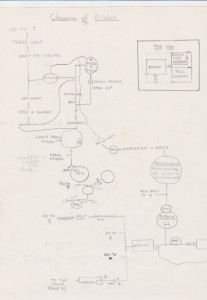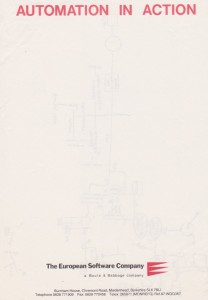Archive for the ‘play’ Category
mapping Fighting Fantasies
I found a folder down the back of a bookshelf. It was the shelf full of Fighting Fantasy books.
The first Fighting Fantasy book that Catherine & I bought was The Forest of Doom from the church jumble sale. I wonder if anyone raised an eyebrow at two little girls buying this?
I was thrilled by it. A book and a maze. A book that was a maze! So I bought more, one by one from the WHSmiths in Enfield shopping centre. I remember being appalled when Black Vein Prophecy cost £3.50. I thought they would always cost £1.95 or maybe £2.50 for a really hefty one. My first introduction to inflation.
The folder is full of maps. Maps of those book mazes.
Some are scrappy, works in progress, tools to help you along.

But some are too perfect and must have been redrawn once the book was completed. As a record, knowledge to be stored away.
There’s a stack on kids’ art paper but one map is drawn on the back of this.
And there’s a great deal of complex figuring out on the back of these green bar computer printouts.
This set is from “Imperial Chemical Industries” so must be stuff that Dad brought home. I remember narrower green bar printouts that Mum would bring home from the Broxbourne council IT department but there is none of that here.
The computer paper records the great frustration of my Fighting Fantasy stage. The Creature of Havoc.
I got stuck with The Creature, every option on every page seemed to lead to death. The map didn’t help. Decoding the encrypted bits in the text didn’t either. I went through the book page by page and found the end point that was about dying horribly. And then tried unsuccessfully to backtrack.
Today, with the internet, it took a few minutes to find out (as I had believed in 1988) the book was broken. But back then I just had to trust to the map.
lessons in frugality from cats
1. Sleep alot
Cats enjoy just lying around. They wallow in laziness. Our two positively scorn me when I rush around getting ready for work. If sleeping is getting boring, then find an exciting new place to sleep. Grumpy Cat challenges herself to squeeze through ever tigher gaps to get into prime sleeping spots.
 |
 |
2. Entertainment can be cheap
Noisy Cat likes elastic bands. Alot. Shop-bought toys don’t hold his attention anywhere near as long.
3. Luxury is simple
Radiators provide cats with obvious joy. In summer sunshine does the same. Best not to discuss their feelings about warm bird guts.
4. Be cute and someone else will feed you
I’m not sure this is something you should try and emulate but both our two fuzzballs were once strays. They hit the jackpot when they sucked up to me, winning a warm house, an easily manipulated lady of the house, no kids, no dogs, and a home where alot of home butchery goes on.
They have to put up with occasional humilating fussing from the humans but mostly the cats seem to have the better deal. They even seem to love their super-cheap cat food, known in our house as kitty-crack.
the text size game
RNIB training seems to include lots of gentle games and quizzes. Our sight loss training included a game that went as follows:
- Give participants the same information printed in different fonts sizes.
- Ask them to answer a question about the information
- Give the first person to answer correctly a metaphorical pat on the back (they need sweets here)
(it was more interesting than it sounds)
The idea being that you very quickly get what font sizes are easy to read. And therefore understand why all RNIB information is printed in 14 point and at first looks screamingly ‘loud’.
treepees
another I want…. a Treepee
I reckon that’d be a good use of the huge ecalyptus that has decided over the years that our garden is way nicer than the place it was planted.
visual research methods
I had the opportunity last week to attend a brilliant course called An Introduction to Visual Methods.
“The aim of this workshop is to provide participants with a step-change career enhancing skills in visual methods; and to provide an ongoing and integrated visual methods resource for researchers with experience in visual methods at intermediate level that is stimulating, challenging and grounded in ‘best practice’.”
Dr Jon Prosser and friends are running an ESRC funded initiative to “build visual method capacity across the social sciences. Part of the initiative was these dirt cheap training courses, aimed at academic and non-academic researchers alike.
The two days involved three hands-on activities and a number of presentations covering:
- Katherine Davies : photo elicitation and family tree drawing to explore family resemblances and sibling relationships
- Stuart Muir: video diaries to explore contemporary rituals
- Rob Walker on children’s photo diaries
- Andrew Clark on map making and walkabouts to understand urban social geography
- Tessa Muncey on auto-ethnography through writing and photos
- David Gauntlett: making documentaries with kids, drawings of celebrities, identity models made of Lego
- Steve Higgins: using cartoon templates to find out childrens views
- Ruth Holliday: using video diaries to explore gender identity
- Jon Prosser on the ethics of visual methods.
There’s a Visual Methods Symposium in July that will explore some of these themes in more depth.
secret garden nursery
I read about the Secret Garden Outdoor Nursery in an article in the Sunday Herald. There’s coverage in the Guardian too.
When the Secret Garden nursery opens next autumn, the children will have none of the games and equipment seen in a normal suburban nursery: plastic see-saws, cushioned vinyl floors and sterilised building blocks. Their curriculum will be devoted to nature walks, rearing chickens, climbing trees, “mud play” and vegetable gardening. Their playground will be the forest, and their shelter a wattle and daub “cob” building with outdoor toilets.
Pileswasp would obviously love it, as will nephew Woody if nomen et omen is true (not the Woody in the article, that’s just coincidence).
recruiting with games
Corporations are increasingly using online games to recruit and train new employees, and just to better keep people in touch.If you’re thinking that maybe you should hide the video game controller from your kids because they’re spending too much time in front of the TV or computer, don’t. What you think is slacking may just be preparing them to become productive members of the workforce when they get older. Their future offices are likely to be heavily digital—especially if they work remotely—and their work may resemble the online games that many now spend hours playing.
we don’t play in the streets anymore
The media frenzy about teenage knife crime reminded me that there was a story in the newspapers a while back about playing in the streets. The story was that only 2 in 10 children play in the streets and parks close to their homes each day, compared to 7 in 10 when their parents were growing up. Traffic was considered to be the main factor that keeps children indoors. The stories were based on a survey commissioned by Play England, a project aiming to help all children in England “to have regular access and opportunity for free, inclusive, local play provision and play space”.
The newspaper stories highlighted teenage gangs (the latest tabloid demons) as another factor in keeping the majority of children off the streets. The actual research states that
“the young people in the study perceived traffic as the greatest danger, far outweighing fears of bullies and gangs, strangers and fear of attack”.
The Play England article goes on to say that one of the problems is “the demonisation of children and young people” which makes the newspaper coverage somewhat ironic.
the Byron child safety review
I wrote in October about the announcement of Tanya Byron’s review into the impact of violent video games on children.
Mind Hacks were recently a good deal more generous than me about Tanya Byron heading up the review:
“Tanya Byron is great. She came to prominence as the resident psychologist on several UK TV parenting programmes but used evidence-based interventions, essentially demonstrating what a clinical psychologist would do if your child got referred for behaviour problems.
Most notably, she obviously knew her shit and is widely respected among clinical psychologists. Despite often being described as a ‘TV psychologist’ she remained working in the NHS at the coal face of clinical work.”
The report is out now and is mostly sensible and balanced which makes me feel like I was unnecessarily skeptical, for example the report says:
Just like in the offline world, no amount of effort to reduce potential risks to children will
eliminate those risks completely. We cannot make the internet completely safe. Because of
this, we must also build children’s resilience to the material to which they may be exposed
so that they have the confidence and skills to navigate these new media waters more
safely.
and
There are new risks presented in online gaming, many of which are similar to the potential
risks to children of other internet use. These games offer new opportunities for social
interaction between children and there are a number of potential benefits for children and
young people from playing video games, including cognitive and educational gains and
simply having fun. Interestingly the evidence to prove these benefits can be as contested
as the evidence of negative effects.
Full report: Safer Children in a Digital World
trading cards are back!
nForm’s 2008 UX Trading Cards Contest
(my goal this year is to make sure I actually talk to everyone I trade with. I started well last year but got a bit ruthless on the final day)







